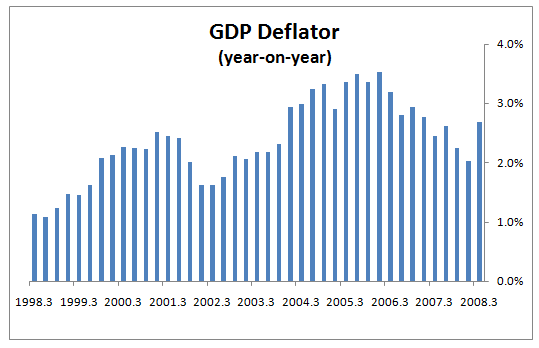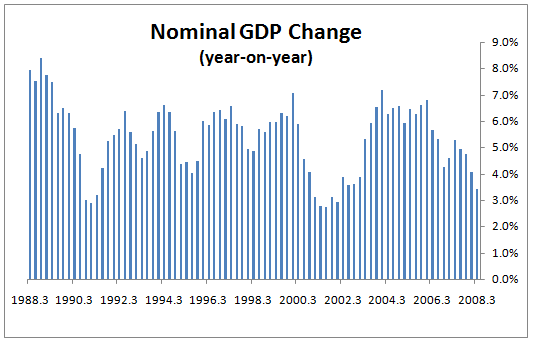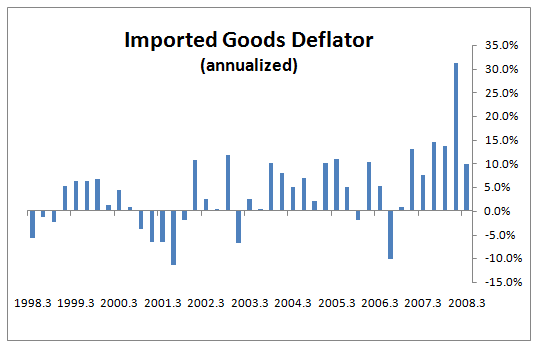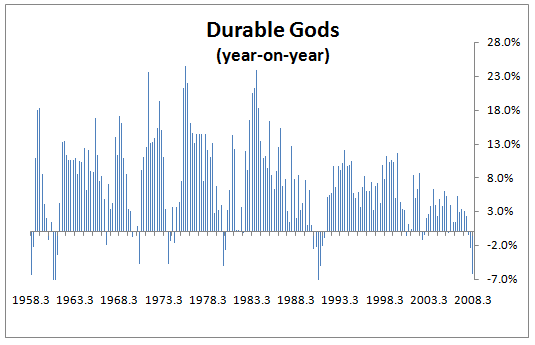Breaking down the Q3 GDP numbers
So the numbers are in and the U.S. economy shrank 0.3% n the third quarter. That is a low number, but it is better than expected. The U.S. economy looks like it is in recession based on these numbers.
However, before we go away thinking that’s the answer, let’s dig a little deeper. I have three key items to watch which should explain the numbers more accurately: the GDP Deflator, Durable Goods, and Private Investment.
Before I dive into the number, let me state up front that I don’t like the numbers as they are reported on TV or in the newspaper. These numbers are distorted in three separate ways: quarter-to-quarter reporting, inflation adjustment and seasonal adjustment. Basically, there are all sorts of ways the government can manipulate the data to make them say whatever they need to say. So, I will be talking about year-on-year seasonally-adjusted nominal GDP This doesn’t remove the seasonal adjustments, but it’s the best set of numbers I have to work with.
Let’s start with the nominal GDP number which is the rawest data I have. This number showed 3.82% growth year-on-year, which is NOT high. In fact, if we adjusted this number by the common inflation measure (the CPI), we would realize that growth over the last year was -1.2%. Clearly, this is recessionary. The chart below should give you a good sense of how high GDP needs to in order to have a robust economy. You can see that recessions coincide with falls in the year-on-year change in GDP. In this business cycle, things started to fall apart after 2007 Q3, which suggests the economy has been in recession for all of 2008.
Next, we can go straight to inflation, since we talked about it above. Here we will be talking about the GDP Deflator. If you don’t know what that is, you’re not alone because it’s an obscure inflation measure used to translate the nominal GDP numbers that are actually compiled into inflation-adjusted terms for you and me. And it often bears no semblance to reality (largely because it excludes exports like oil)
What is interesting about the deflator this time is that the deflator is MUCH higher than last quarter. The GDP deflator was clocking in at an annual 4.2% clip, whereas last quarter it was a preposterous 1.1% and in Q1 it was a hardly more believable 2.6%. I have been looking for ways to explain this increase in the deflator and can’t. If anyone knows, please write me and tell us. Jake from EconomPic Data does a bang up job of explaining why higher import prices worked to lower the GDP deflator. His analysis is well worth the read (read here). The only bone I would have to pick with his analysis is that I think the GDP deflator is adjusted downward to reflect the high import prices rather than the nominal import number itself being adjusted. I will get to the bottom of this. See my added chart below.
But, the long and short of this is that this monumental increase in the deflator has adjusted everything down. If GDP were measured using last quarter’s deflator it would have been over 2.5% growth. If GDP had been measured using this quarter’s deflator every quarter for the past four quarters would have been negative. Obviously, something is wrong with this strong a disconnect from one quarter to the next. Notice the improbable spike in the deflator last quarter in the chart below. Given that inflation is now 5.0%, my take 0n this debate says we have been in recession for a while now.

The next most important caveat comes from the numbers for durable goods like washing machines and refrigerators. Here, the numbers fell off a cliff in Q3. Purchases of durable goods was down 6.25% on the year and an annualized 15% from Q2. Non-durables and services, which we need day-to-day, id not decrease in Q3. And, remember, all of these are nominal dollars. So, an outright decline of this magnitude is severe: the worst since 1991 and second worst since 1961. So, that’s where the rubber meets the road: consumers cut back on durable goods purchases
The last item to note is private investment. This is a volatile figure that rises sharply in upturns and swings down violently in downturns. In the year to Q3, it was down 7.6%. Cut backs on investment were concentrated in residential investment. Makes sense.
However, this is not the end of the downturn in private investment because we saw a much larger 12.5% decline in the last recession in 2001 Q4 and 11.2% in 1991. Expect this figure to be much worse next quarter.
Looking forward to Q4, we should expect an elevated GDP deflator and similar levels of durable good cutbacks. However, private investment will be much lower. Add in some cut backs in day-to-day purchases and we should expect a very large negative number for Q4.



Comments are closed.